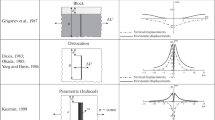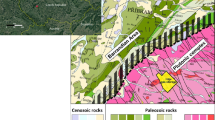Abstract
The results of long-term repeated levelling observations with increased spatial and temporal resolution (distance between benchmarks of 0.3–0.5 km or less and intervals between measurements of 0.5–1.0 years) at oil and gas fields and underground gas storage in Russia and Turkmenistan are considered. Various forms of deformations were found: a weak general uplift or absence of subsidence of the within oil fields, the absence of subsidence during long-term development of a gas field, cyclic deformations (uplift and subsidence) during injection and withdrawal at underground gas storage, and local subsidence in fault zones at all facilities (including underground gas storage during the period of gas injection). Three-dimensional analytical models of deformations of the surface of a weightless elastic half-space with prismatic poroelastic inclusions and inhomogeneous mechanical properties (bulk elastic moduli) are constructed. To assess the total subsidence in oil and gas fields caused by a decrease in reservoir pressure, the solution for a weightless medium was modified to take into account the weight of the overlying rocks, the dynamics of changes in poroelastic parameters, and the genesis of the field formation. It is shown that superposition of solutions for displacements of the half-space containing inclusion and inhomogeneity may explain paradoxical phenomena such as the absence of subsidence during the long-term development of a gas field and the presence of local subsidence under conditions of gas injection into an underground storage. The calculations are compared with the data of repeated geodetic observations to obtain consistent parameters of the development and operation of the underground gas storage.










Similar content being viewed by others
REFERENCES
Adushkin, V.V., Tectonic earthquakes of anthropogenic origin, Izv., Phys. Solid Earth, 2016, vol. 52, no. 2, pp. 173–194.
Adushkin, V.V. and Turuntaev, S.B., Tekhnogennaya seismichnost' – indutsirovannaya i triggernaya (Induced and Triggered Anthropogenic Seismicity), Moscow: IDG RAN, 2015.
Converse, G. and Comninou, M., Dependence on the elastic constants of surface deformation due to faulting, Bull. Seismol. Soc. Am., 1975, vol. 65, no. 5, pp. 1173–1176.
Davies, J.H., Elastic field in a semi-infinite solid due to thermal expansion or a coherently misfitting inclusion, J. Appl. Mech., 2003, vol. 70, pp. 655–660.
Doglioni, C., A classification of induced seismicity, Geosci. Front., 2018, vol. 9, pp. 1903–1909.
Dyskin, A., Pasternak, E., and Shapiro, S., Fracture mechanics approach to the problem of subsidence induced by resource extraction, Eng. Fract. Mech., 2020, vol. 236, pp. 107–130.
Eshelby, J.D., Elastic inclusions and inhomogeneities, in Progress in Solid Mechanics, Sneddon, I.N. and Hill, R., Eds., Amsterdam: North-Holland, 1961, vol. 2, pp. 87–140.
Fokker, P.A. and Orlic, B., Semi-analytic modeling of subsidence, Math. Geol., 2006, vol. 38, no. 5, pp. 565–589.
Geertsma, J., A remark on the analogy between thermoelasticity and the elasticity of saturated porous media, J. Mech. Phys. Solids, 1957a, vol. 6, pp. 13–16.
Geertsma, J., The effect of fluid pressure decline on volumetric changes in porous rocks, Trans. AIME, 1957b, vol. 210, pp. 331–340.
Geertsma, J., Land subsidence above compacting oil and gas reservoirs, J. Petrol. Technol., 1973, vol. 50, pp. 734–744.
Goodier, J.N., On the integration of the thermoelastic equations, Philos. Mag., 1937, vol. 7, pp. 1017–1032.
Izyumov, S.F. and Kuz’min, Yu.O., Study of the recent geodynamic processes in the Kopet-Dag region, Izv., Phys. Solid Earth, 2014, vol. 50, no. 6, pp. 719–731.
Kashnikov, Yu.A. and Ashikhmin, S.G., Mekhanika gornykh porod pri razrabotke mestorozhdenii uglevodorodnogo syr’ya (Mechanics of Rocks in the Development of Raw Hydrocarbon Deposits), Moscow: Gorn. kniga, 2019.
Khisamov, R.S, Gatiyatullin, N.S., Kuz’min, Yu.O., et al., Sovremennaya geodinamika i seismichnost' yugo-vostoka Tatarstana (Modern Geodynamics and Seismicity of Southwestern Tatarstan), Khisamov, R.S. and Kuz’min, Yu.O., Eds., Kazan’: Fen, 2012.
Kuzmin, Yu.O., Sovremennaya geodinamika i otsenka geodinamicheskogo riska pri nedropol’zovanii (Recent Geodynamics and Geodynamic Risk Assessment in Natural Resources Management), Moscow: AEN, 1999.
Kuzmin, Yu.O., Recent geodynamics of a fault system, Izv., Phys. Solid Earth, 2015, vol. 51, no. 4, pp. 480–485.
Kuzmin, Yu.O., Recent geodynamics of dangerous faults, Izv., Phys. Solid Earth, 2016, vol. 52, no. 5, pp. 709–722.
Kuzmin, Yu.O., Paradoxes of the comparative analysis of ground-based and satellite geodetic measurements in recent geodynamics, Izv., Phys. Solid Earth, 2017, vol. 53, no. 6, pp. 825–840.
Kuzmin, Yu.O., Recent geodynamics of tensile faults, Izv., Phys. Solid Earth, 2018, vol. 54, no. 6, pp. 886–903.
Kuzmin, Yu.O., Induced deformations of fault zones, Izv., Phys. Solid Earth, 2019a, vol. 55, no. 5, pp. 753–765.
Kuzmin, Yu.O., Recent geodynamics: from crustal movements to monitoring critical objects, Izv., Phys. Solid Earth, 2019b, vol. 55, no. 1, pp. 65–86.
Kuzmin, Yu.O., Geodynamical evolution of the Earth’s crust of Central Asia and recent geodynamics of the Kopet Dag region, Turkmenistan, Izv., Phys. Solid Earth, 2021, vol. 57, no. 1, pp. 131–139.
Marketos, G., Govers, R., and Spiers, C.J., Ground motions induced by a producing hydrocarbon reservoir that is overlain by a viscoelastic rock salt layer: A numerical model, Geophys. J. Int., 2015, vol. 203, pp. 228–242.
Maysel, V.M., A generalization of the Betti–Maxwell theorem to the case of thermal stresses and some of its applications, Dokl. Acad. Nauk. USSR, 1941, vol. 30, pp. 115–118.
Mindlin, R.D. and Cheng, D.H., Nuclei of strain in the semi-infinite solid, J. Appl. Phys., 1950, vol. 21, pp. 926–933.
Mironov, V.S., Kurs gravirazvedki (A Course in Gravity Exploration), Leningrad: Nedra, 1972.
Mura, T., Micromechanics of Defects in Solids, Norwell: Kluwer Academic, 1987.
Nikolaev, A.V., Problems if induced seismicity, in Navedennaya seismichnost' (Induced Seismicity), Moscow: Nauka, 1994, pp. 5–15.
Nowacki, W., Thermoelasticity, Warsaw: PWN; Oxford: Pergamon, 1986.
Rice, J.R. and Cleary, M.P., Some basic stress diffusion solutions for fluid-saturated elastic porous media with compressible constituents, Rev. Geophys. Space Phys., 1976, vol. 14, pp. 227–241.
Rudnicki, J.W., Alteration of regional stress by reservoirs and other inhomogeneities: Stabilizing or destabilizing?, in Proc. 9th Int. Cong. Rock Mechanics, Paris, Aug. 25–29, 1999, Vouille, G. and Berest, P., Eds., Rotterdam: Balkema, 2002a, vol. 3, pp. 1629–1637.
Rudnicki, J.W., Eshelby transformations, pore pressure and fluid mass changes, and subsidence, in Poromechanics II: Proc. 2nd Biot Conf. on Poromechanics, Grenoble, Aug. 26–28, Auriault, C., Geindreau, P., Royer, J.-F., Bloch, C., Boutin, J., and Lewandowska, J., Eds., Rotterdam: Balkema, 2002b, pp. 307–312.
Segall, P., Stress and subsidence resulting from subsurface fluid withdrawal in the epicentral region of the 1983 Coalinga earthquake, J. Geophys. Res., 1985, vol. 90, pp. 6801–6816.
Segall, P., Earthquakes triggered by fluid extraction, Geology, 1989, vol. 17, pp. 942–946.
Segall, P., Induced stresses due to fluid extraction from axisymmetric reservoirs, Pure Appl. Geophys., 1992, vol. 139, pp. 535–560.
Segall, P., Earthquake and Volcano Deformation, Princeton: Princeton Univ. Press, 2010.
Segall, P., Grasso, J.-R., and Moscop, A., Poroelastic stressing and induced seismicity near the Lacq gas field, South-Western France, J. Geophys. Res., 1994, vol. 99, no. B8, pp. 15423–15438.
Shapiro, S.A., Fluid-Induced Seismicity, Cambridge: Cambridge Univ. Press, 2015.
Sokolnikoff, S., Mathematical Theory of Elasticity, New York: McGraw-Hill, 1956.
Subsidence due to Fluid Withdrawal, Chilingarian, G.V., Donaldson, E.C., and Yen, T.F., Eds., Amsterdam: Elsevier, 1995.
Tsurkis, I.L. and Kuzmin, Yu.O., Stress state of an elastic plane with one or more inclusions of arbitrary shape: The case of identical shear moduli, Mech. Solids, 2022, vol. 57, no. 1.
Turcotte, D.L. and Shubert, G., Geodynamics, Cambridge: Cambridge Univ. Press, 2002.
Walsh, J.B., Subsidence above a planar reservoir, J. Geophys. Res., 2002, vol. 107, no. B9.
Wang, H.F., Theory of Linear Poroelasticity with Applications to Geomechanics and Hydrology, Princeton: Princeton Univ. Press, 2000.
Zhukov, V.S. and Kuzmin, Yu.O., The influence of fracturing of the rocks and model materials on p-wave propagation velocity: Experimental studies, Izv., Phys. Solid Earth, 2020, vol. 56, no. 4, pp. 470–480.
Zimmerman, R., Compressibility of Sandstones, Amsterdam: Elsevier, 1991.
Zoback, M.D., Reservoir Geomechanics, Cambridge: Cambridge Univ. Press, 2007.
Zoback, M. and Kohli, A., Unconventional Reservoir Geomechanics: Shale Gas, Tight Oil, and Induced Seismicity, Cambridge, 2019.
Funding
This work was carried out as part of the State Task for the Schmidt Institute of Physics of the Earth, Russian Academy of Sciences.
Author information
Authors and Affiliations
Corresponding author
Ethics declarations
The author declares that he has no conflicts of interest.
Additional information
Translated by M. Hannibal
Rights and permissions
About this article
Cite this article
Kuzmin, Y.O. Deformation Consequences of the Development оf Oil and Gas Field. Izv. Atmos. Ocean. Phys. 57, 1479–1497 (2021). https://doi.org/10.1134/S0001433821110062
Received:
Accepted:
Published:
Issue Date:
DOI: https://doi.org/10.1134/S0001433821110062




